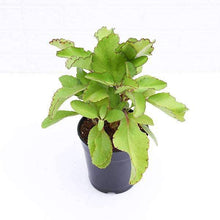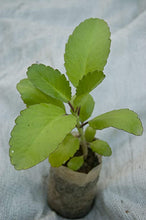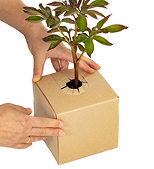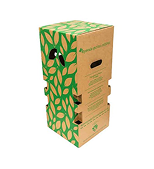Bryophyllum pinnatum - Plant





Bryophyllum pinnatum - Plant




Damaged or lifeless? We’ll replace it for free. Learn more

Double layered custom boxes to protect plants during shipping.

Air vents for proper air-flow

To preserve plant freshness during transit

Details steps of how to grow and maintain your plant
Bryophyllum pinnatum is widely used in the ayurvedic system of medicine as an astringent, analgesic, and carminative. It is naturalized throughout the hot and moist parts of India. The leaves of B. pinnatum have a variety of uses in the traditional system of medicine in India. It is also known as the air plant, cathedral bells, life plant, miracle leaf, and Goethe plant is a succulent plant native to Madagascar, which is a popular houseplant and has become naturalized in tropical and subtropical areas. In Bengali, it can be called 'Pathar Kuchi'.
Cultural and Traditional Significance
- In many regions, Bryophyllum pinnatum is appreciated for its traditional significance and versatile applications.
- The plant is often incorporated into gardens not only for its aesthetic appeal but also for its cultural importance in various traditional practices.
- The leaves of Bryophyllum pinnatum are known to be edible, offering a unique addition to culinary creations. They are most flavorful in early spring or winter, providing a mild, pleasant taste.
- These leaves can be used both cooked and raw, making them a versatile ingredient for salads and other dishes.
Note - Please Consult your Health Expert before using it for medicinal purposes.
INSIDE THE BOX
| S.No. | PRODUCT NAME | DIMENSION |
| 1. | Bryophyllum Plant | <1 Feet Height |
| 2. | Growing Pot (Black colour) | 6 Inch |
**above specifications are for indicative purpose only, actual dimensions may slightly vary.
INITIAL CARE FOR 10-15 DAYS JUST AFTER RECEIVING YOUR PLANT
- Remove the Packaging Materials carefully.
- Press the soil in the pot & add additional soil(garden mix) if necessary.
- Maintain moisture in the pot, Do not overwater it may kill your plant, so make sure that the soil should be dry between watering.
- Make sure that plants get enough morning direct bright light(2-3hrs) for 10-15 days & do not go for immediate transplanting (minimum 1 month)
- After 1 month you can transplant it into a slightly bigger pot than the present pot or you can remain in the same pot for 6-7 months.
- Just prune if any branch of the plant is get damaged in transits. New leaves will come definitely.
Selected plant of 8-10 inches
Planted into a 5-inch pot
With healthy, moisture-retaining soil
A care instruction sheet for maintenance guide

Get in touch for best pricing on bulk orders and landscaping projects.
 WhatsApp us
WhatsApp us

Call on 9177805454 (Mon-Sat, 9 AM-6 PM) or WhatsApp us – we’re here to help.
About Exotic Flora
At Exotic Flora, we’re passionate about bridging the gap in bringing plants to everyone. With over 500+ varieties across 7 plant categories, from exotic finds to everyday greens, we bring the entire range to you.
Our plants, sourced from all parts of India are nurtured at Kadiyam, in our 25 acres in-house nursery by a team of expert horticulturists. Once they are ready we ship all our plant varieties across India.
Our services go beyond safe delivery of plants. A dedicated support team is there to help you with any maintenance queries you may have.
At Exotic Flora we always believe in going that extra mile, because everyone should have the plants they love.
Every plant has different plant parts to use as a medicinal plant it may be in its leaves, roots, stems, flowers or other parts of the plant. For full details look at the descriptions of individual plants.
Citronella grass, Lemon grass, Rosemary, Marigold, Mint Tulasi etc
Some plants need indirect bright light & others need direct bright light and some can grow in both direct and indirect sunlight. So please look at the description of each individual plants.
The soil should be well drained, fertile and rich in organic content. A mixture of garden soil, cocopeat, compost will give the best results for your plants.
Remember overwater can kill your plant(make sure that your pot should have drainage hole). Water when the topsoil(2-3 inch) feels dry to touch. In general moderate watering(in every 3-4 days)
Regular pruning of diseased and damaged parts of the plants. Regular watering, proper ventilation & sunlight, organic manure & fertilizers application.
In general you can grrow in indirect bright light conditions like basil, rosemary, mint, Centella asiatica, Maghai paan / betel leaf.
Tulsi has been used for thousands of years in Ayurveda for its diverse healing properties apart from devotional purpose.
No, both are different plants, Tulsi which is commonly known as holy basil, where as mint tulsi is closely related to holy basil & doesn't have devotional property.
Stevia is a sugar substitute made from the leaves of the stevia plant. It's about 100 to 300 times sweeter than table sugar, but it has no carbohydrates, calories, or artificial ingredients.
Costus igneus, commonly known as insulin plant in India. Consumption of the leaves are believed to lower blood glucose levels, and diabetics.